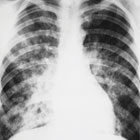Four clinical signs can improve GP pneumonia diagnosis, finds study

GPs may be able to spot pneumonia and therefore avoid unnecessary antibiotics by looking out for four simple clinical signs.
Researchers said these signs could be strong predictors for pneumonia, allowing GPs to spot it more easily.
The study, led by researchers from the University of Southampton, looked at data for 720 patients who were radiographed within a week of an initial consultation for acute cough associated with an LRTI. Of these patients, 115 were marked as having a definite or probable case of pneumonia.
The researchers found that presenting symptoms, such as shortness of breath, were not helpful for making a diagnosis of pneumonia, but clinical examination findings, including raised temperature, crackles on auscultation, oxygen saturation of less than 95% and rapid pulse, were strong positive predictors for pneumonia in those who had the diagnosis confirmed by radiograph.
These four signs held true even when the diagnoses of ‘possible pneumonia’ were removed from the dataset.
Analysis found the positive predictive value for all four signs in those who were radiographed was just over 20%, meaning that around one in five of the patients radiographed who had at least one sign had pneumonia.
They said in the paper: ‘The four variables identified by this analysis are easily measured clinical signs. Although pulse oximetry is not routinely measured, it is a robust and inexpensive technology that is widely available. If antibiotic prescribing was restricted to people who had one or more of these signs, it could substantially reduce antibiotic prescribing for this condition.
‘Clinicians should be aware that the model was derived in those with more severe symptoms referred for radiographs and that effective clinical safety-netting would be needed to cope with missed cases of pneumonia.’
Lead author and professor of primary care health research at the University of Southampton Professor Michael Moore commented: ‘It is notoriously difficult to tell one infection from the other. GPs fail to spot two out of every three cases of pneumonia, although those which are missed are the milder ones with less distinctive features. One of the reasons GPs offer antibiotics is that they are rightly concerned about missing a serious illness
‘The rise in drug-resistant infections is an international priority and one of the contributors to antibiotic resistance is unnecessary prescribing. Most patients with a lower respiratory tract infection will recover perfectly well without antibiotics but, at the moment, around 60% of patients get a prescription.
‘Finding ways of identifying those at low risk of complications should help reduce this figure. If antibiotic prescribing was restricted to people who had one or more of these signs it could result in a substantial reduction in unnecessary prescriptions for this condition.’
Eur. Respir. J. 2017; available online 23 November
Pulse October survey
Take our July 2025 survey to potentially win £1.000 worth of tokens

Visit Pulse Reference for details on 140 symptoms, including easily searchable symptoms and categories, offering you a free platform to check symptoms and receive potential diagnoses during consultations.










